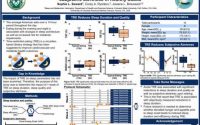Cytosponge-AI combo could help doctors diagnose Barrett’s esophagus

Cancer Research UK-funded researchers have developed a new technique to help experts diagnose Barrett’s esophagus—a pre-cancerous condition that can increase the risk of developing oesophageal cancer.
Published today in Nature Medicine, the study explored how artificial intelligence could help free up pathologists time and allow them to focus on diagnosing the trickiest cases of Barrett’s esophagus.
Cytosponge is a new diagnostic tool developed by Cancer Research UK scientists at the University of Cambridge. It uses a ‘sponge on a string’ to collect cells from the esophagus, which are then sent to the lab for testing, where pathologists look for a biomarker linked to Barrett’s esophagus, TFF3.
Previous research has suggested that the Cytosponge-TFF3 test can identify 10 times more people with Barrett’s esophagus than current GP care. However, if this test were to be more commonly used in GP surgeries and elsewhere within the NHS, it could increase the demand on NHS services.
Dr. Marcel Gehrung, based at the Cancer Research UK Cambridge Institute, spent his Ph.D. on the study and set up a spin-out company called Cyted from the work. “A major bottleneck for scaling Cytosponge to test large patient populations is the time it takes for a pathologist to analyze the samples, which has several time-consuming steps.”
What is Barrett’s esophagus?
Barrett’s esophagus can cause cells in the esophagus to grow abnormally, increasing the risk of oesophageal cancer. Around 3 to 13% of people with the Barrett’s esophagus develop a type of oesophageal cancer called oesophageal adenocarcinoma—11 times more than the average person.
It’s thought that many cases of Barrett’s esophagus go undetected.
Researchers, led by Dr. Florian Markowetz at Cancer Research UK Cambridge Institute, wanted to see if AI could help ease the burden of analyzing samples, paving the way for Cytosponge to be used more frequently without straining an already busy NHS care pathway.
The researchers developed an approach that applied deep-learning (an AI function that tries to mimic the workings of the brain and process raw data without human oversight) to Cytosponge samples taken from 2,331 patients taking part in clinical trials. Images from these samples were analyzed by the model and trained to understand the features of particular cells that indicate the presence of Barrett’s esophagus, called goblet cells.
Coding a pathologist’s partner
Trying to develop a fully-automated system with the ability to mimic a pathologist’s single “positive” or “negative” diagnosis was complex. From the samples taken from 2,331 patients, pathologists were able to correctly identify 82% of Barrett’s esophagus cases. In comparison, the AI approach was able to correctly identify 73% of cases, with both approaches correctly identifying 93% of the negative cases.
Instead, researchers were guided by experienced pathologists to develop a semi-automated triage system. This meant that the result for each sample was categorized into one of eight different classes depending on how clear cut the diagnosis and quality was. Samples that were deemed to be low quality or more challenging for the deep-learning model were assessed manually by pathologists.
This triage system proved successful. When applied to the clearer cut cases (approximately 60% of the samples), the algorithm was able to identify 83% of cases.
Researchers suggest that it could reduce Cytosponge-related workload for pathologists by 57%.
The future of AI
Michelle Mitchell, chief executive of Cancer Research UK, said that pathologists play a key role in diagnosis. “But like so many other areas of the NHS, they have been seriously impacted by a lack of investment in workforce over the years. Research such as this, exploring how to support pathologists in their vital work through new technology and innovations is vital, as is long term investment and planning of the cancer workforce.”
Source: Read Full Article


